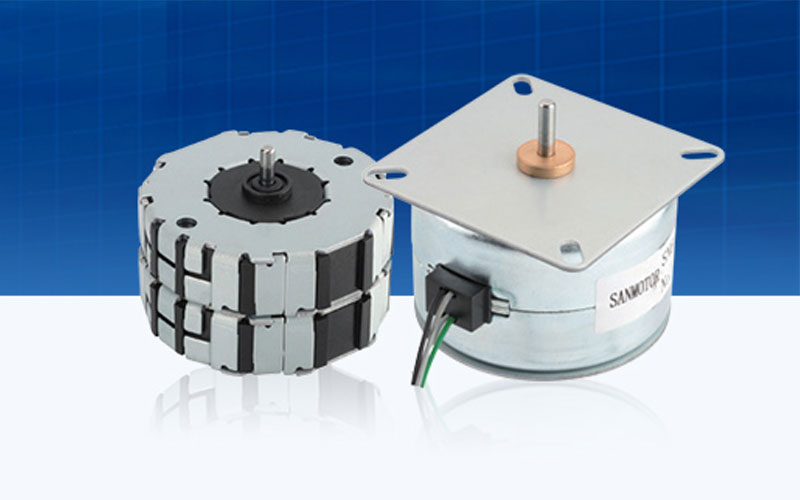Synchronous motors are frequently utilized in the field of electric motors for applications that call for exact speed control. The frequency of the power source and the motor’s pole count determine the synchronous speed, or steady speed at which these motors run.
This article aims to provide an in-depth comparison of these two motor types, highlighting their differences, advantages, disadvantages, and typical applications.

Overview of Synchronous Motors
Electric motors that revolve at a speed exactly proportionate to the supply frequency are known as synchronous motors. Unlike induction motors, which require slip to operate, synchronous motors do not experience slip, meaning they run at a constant speed under stable conditions. These motors can either be excited or non-excited, depending on the method used to energize the rotor.
Excited Synchronous Motors
Excited synchronous motors are the traditional type, where the rotor requires external excitation (a magnetic field) to function. This excitation is typically provided through a separate DC excitation system, often using slip rings and brushes. The motor generates torque by energizing the rotor windings with an external power source.
Non-Excited Synchronous Motors
Conversely, external excitation is not necessary for non-excited synchronous motors. These motors do not require slip rings or a DC power source because the rotor can be a permanent magnet or based on reluctance. Depending on the rotor design, these motors are also known as reluctance synchronous motors or permanent magnet synchronous motors (PMSM).
Key Differences Between Non-Excited and Excited Synchronous Motors
The primary distinction between non-excited and excited synchronous motors lies in how they generate the rotor magnetic field. Below, we compare the two based on several factors:
| Factor | Non-Excited Synchronous Motors | Excited Synchronous Motors |
| Rotor Type | Permanent magnet or reluctance | Wound rotor with external excitation |
| Excitation System | No external excitation required | Requires an external DC excitation system |
| Complexity | Simpler design | More complex due to external excitation components |
| Efficiency | Higher efficiency, no losses in excitation system | Slightly lower efficiency due to losses in excitation system |
| Control | Suitable for applications requiring less precise control | Provides precise control over speed and power |
| Maintenance | Requires less maintenance | Requires maintenance due to slip rings and brushes |
| Cost | Typically lower cost | Higher cost due to additional components (excitation system) |
| Applications | Suitable for variable speed drives and small applications | Ideal for large industrial applications requiring high precision |
Excitation System Comparison
Excited Synchronous Motors
An external DC excitation system is used by excited synchronous motors to generate a magnetic field in the rotor. The excitation power is typically provided by a separate source, either through brushes and slip rings or through a brushless exciter. This system requires constant monitoring and maintenance, as the slip rings and brushes can wear over time. The excitation system also contributes to additional energy consumption, slightly lowering the motor’s efficiency.
Non-Excited Synchronous Motors
Permanent magnets or reluctance-based rotors are used in non-excited synchronous motors, which do not need an external excitation system. Reluctance motors work on the basis of variable reluctance, whereas permanent magnet synchronous motors (PMSM) require powerful magnets integrated in the rotor. These designs eliminate the need for an external excitation system, resulting in reduced complexity, lower maintenance costs, and higher efficiency.
Motor Efficiency
Efficiency is a key factor when choosing the appropriate motor for an application. Let’s compare the efficiency of both motor types:
- Excited Synchronous Motors: Although these motors are efficient, they suffer from some losses in the excitation system. The DC power supplied to the rotor creates heat losses and increases energy consumption. The need for a separate excitation system and the presence of slip rings can also introduce additional losses.
- Non-Excited Synchronous Motors: Synchronous motors that are not stimulated are typically more effective. With the absence of a complex excitation system and the use of permanent magnets or reluctance-based rotors, these motors experience fewer energy losses. The direct coupling between the rotor and the stator field ensures better efficiency.
Efficiency Comparison:
| Motor Type | Efficiency (%) |
| Excited Synchronous Motors | 85-92% |
| Non-Excited Synchronous Motors | 92-98% |
Cost and Complexity
Excited Synchronous Motors
Excited synchronous motors are typically more expensive due to the additional components required for the excitation system. The need for brushes, slip rings, and an external DC power supply increases both the initial cost and operational cost. Additionally, the complexity of the motor means more parts that could potentially fail, leading to higher maintenance requirements.
Non-Excited Synchronous Motors
Non-excited synchronous motors are easier to develop and produce at a lower cost. There are no slip rings or external excitation systems, making these motors cheaper to produce and maintain. The use of permanent magnets or reluctance rotors eliminates the need for an additional power supply for the rotor, further lowering the cost.
Applications
Excited Synchronous Motors
Applications requiring exact control over speed and torque, such synchronous generators, power plants, and huge industrial machinery, frequently use excited synchronous motors.
They are ideal for large-scale applications, such as pumps, compressors, and large drives that require high starting torque and constant speed under varying load conditions.
Non-Excited Synchronous Motors
Applications requiring high efficiency and simpler systems employ non-excited synchronous motors, particularly permanent magnet synchronous motors (PMSMs).
These motors are widely employed in robotics, automotive applications (such as electric vehicles), HVAC systems, and small-scale industrial applications. PMSMs are particularly suitable for variable-speed drives due to their high efficiency and compact size.
Applications Comparison:
| Motor Type | Common Applications |
| Excited Synchronous Motors | Large industrial machinery, power plants, synchronous generators, pumps, compressors |
| Non-Excited Synchronous Motors | Robotics, electric vehicles, HVAC systems, small-scale industrial applications, precision machinery |
Advantages and Disadvantages
Advantages of Excited Synchronous Motors:
- High Starting Torque: Excited motors are appropriate for heavy-load applications because they may produce a high starting torque.
- Precise Speed Control: They are perfect for applications where exact speed management is crucial because they provide exceptional speed control.
- Reliability in Large Applications: Their ability to operate under varying loads without losing synchronization makes them reliable in large-scale operations.
Disadvantages of Excited Synchronous Motors:
- Complexity: The need for slip rings, brushes, and an external excitation system makes them more complex.
- Maintenance: Regular maintenance is necessary for the external excitation system, which raises operating expenses and downtime.
- Lower Efficiency: The external excitation system leads to energy losses, reducing overall efficiency.
Advantages of Non-Excited Synchronous Motors:
- High Efficiency: With no need for external excitation, non-excited motors tend to be more efficient.
- Lower Maintenance: Maintenance requirements are decreased by the removal of brushes and slip rings.
- Simplicity: Due to their ease of development and operation, these motors are more cost-effective over the long run.
Disadvantages of Non-Excited Synchronous Motors:
- Lower Starting Torque: Non-excited motors generally have lower starting torque compared to excited synchronous motors.
- Limited Control: These motors may not provide the same level of precise speed control as excited motors in certain applications.
- Size Limitations: Due to the reliance on permanent magnets or reluctance rotors, non-excited motors can be limited in size and power output.
Conclusion
Both non-excited and excited synchronous motors have their place in modern industrial applications. Excited synchronous motors are preferred in high-torque, large-scale operations that require precise control and constant speed under varying loads. However, these motors come with higher costs, increased complexity, and maintenance needs.
Non-excited synchronous motors, particularly permanent magnet synchronous motors, offer high efficiency, simpler design, and lower maintenance costs. They are ideal for smaller-scale applications or those requiring variable-speed control with less emphasis on starting torque.
Ultimately, the choice between non-excited and excited synchronous motors depends on the specific needs of the application, including cost, efficiency, torque, control precision, and maintenance requirements. Understanding the differences between these two motor types helps in selecting the right motor for the job, optimizing performance, and reducing operational costs.

